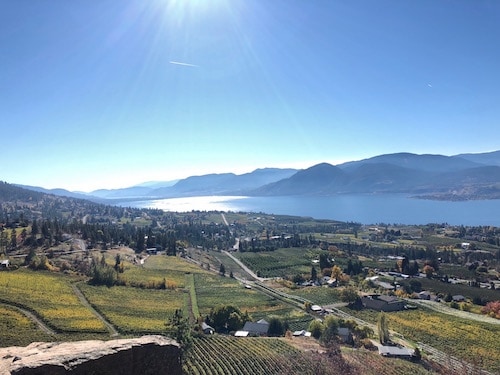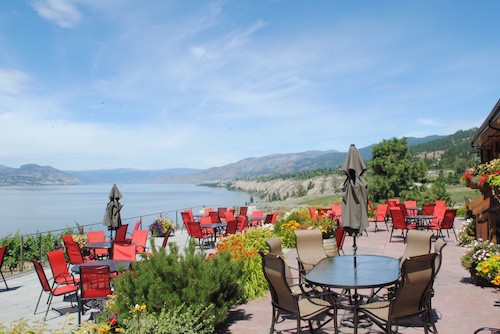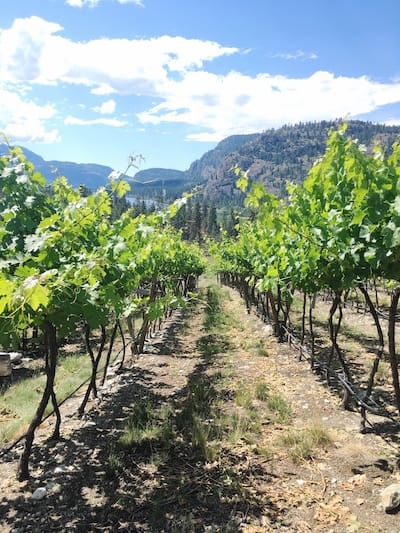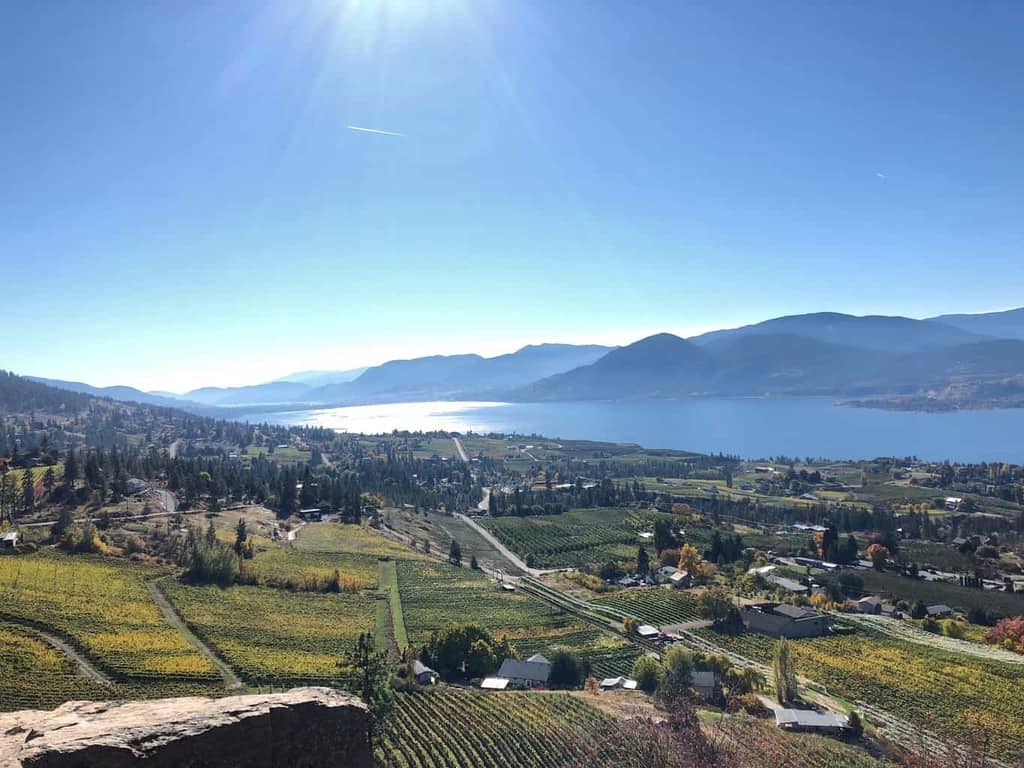Beautiful British Columbia. It’s so beautiful this phrase is imprinted on every license plate. Each year new international travelers find their way to Canada’s most western province in search of an experience in the great outdoors. Still, agricultural development – including viticulture – has been a key ingredient in the recipe to BC’s tourism successes.
Before we start the tour, we need to acknowledge the history here. BC is the place it is because of its Indigenous peoples; the province is home to one-third of Canada’s First Nations with the second largest Indigenous population. Some areas of southern BC have signage in English and Syilx and there are two Indigenous wineries, offering opportunities to see a Salish language in print. Limləmt (thank you) to these First Nations, through whose traditional lands we travel.

The British Columbia Wine Region
British Columbia has more than 270 grape wineries (plus fruit wineries) in nine official geographical indications (or GIs) with two sub-GIs. Governed by the BC Wine Authority and marketed by the Wines of British Columbia, this wine industry is young by international measure: BC has 10,200 acres of vines, with Napa (California) at more than 46,000 acres and Burgundy well over 70,000. Although smaller, BC has seen rapid growth and already has its toes on the worldwide wine stage.
From west to east, these are the growing regions of British Columbia.
Vancouver Island
- Wineries: +30
- 50 vineyards with +400 acres
- Top Planted Grapes: Pinot Noir, Pinot Gris, Foch, Ortega, Gewürztraminer
The first commercial vineyard here was planted in the 1970s, and much of the wine produced today stays on the Island with some making its way to Vancouver area restaurants and retailers. A cooler Mediterranean coastal climate, vineyards are shielded from weather extremes by mountains and temperatures are moderated by the Pacific Ocean.
What to Drink
- Classic: Blue Grouse “Paula” Sparkling (traditional method) or Pinot Gris
- Adventurous: Averill Creek Charme de L’ile (charmat) or Pinot Noir
- Exploratory: Emandare Vineyard, whatever isn’t sold out
RELATED: Sparkling Wine vs. Champagne — What’s The Difference?
Where to Eat:
- Classic: Unsworth Vineyards, Mill Bay
- Adventurous: Red Fish Blue Fish, Victoria Harbour (seasonal)
- Exploratory: Wild Mountain, Sooke
Where to Stay:
- Classic: Grouse House, Blue Grouse Estate Winery & Vineyard
- Anywhere by the water, because it’s an island
Gulf Islands
- Wineries: +12
- 16 vineyards with +94 acres
- Top Planted Grape Varieties: Pinot Noir, Maréchal Foch, Pinot Gris, Ortega
A group of small islands (Salt Spring, Pender, Saturna, Quadra, Hornby, Denman, and Thetis) between larger Vancouver Island and the mainland in what’s known as the Georgia Straight. A mild coastal climate helps keep temperatures moderate, and low rainfall brings its own irrigation challenges. Eclectic as only a collection of islands can be.
What to Drink
- Adventurous: Sea Star
Where to Eat
- Adventurous: ALL the fresh seafood
Where to Stay
- Adventurous: AirB&B, B&Bs
RELATED: An Introduction To Canadian Wine Country: The Wine Regions of Canada
Fraser Valley
- Wineries: +40
- 32 vineyards with +200 acres
- Top Planted Grape Varieties: Siegerrebe, Pinot Gris, Chardonnay, Bacchus, Pinot Noir
Close proximity to the city makes this ideal exploration grounds for those on a layover or wanting to stay near the main hub of Vancouver. Rich farmland with a long growing history, the Fraser Valley has strong agricultural roots. It’s a cooler climate growing with higher rainfall and decent diurnal temperatures. Some pressures from moisture, but it’s a risk growers are willing to take.
What to Drink
- Classic: Vista D’oro “D’oro” fortified
- Adventurous: Singletree Winery Grüner Veltliner (yes) or Siegerrebe
Where to Eat
- Classic: any of a dozen winery restaurants or bistros, from deli and picnic fare to full service
Where to Stay
Insider tip: head to Vancouver for cool digs – it’s not far, promise
- Classic: Pan Pacific Hotel Vancouver
- Adventurous: Listel Hotel Vancouver
- Exploratory: any of the slightly dodgy motels where the X-Files was filmed, because the truth is out there
RELATED: 11 Delicious Facts About Port and Fortified Wine
Lillooet (New 2018)
- Wineries: 1
- 7 vineyards with +30 acres
- Top Planted Grape Varieties: Riesling, Chardonnay, Pinot Gris, Pinot Noir, Cabernet Franc
An old gold panning town from the days with outposts that furnished supplies to prospectors who paid in nuggets. Vinifera vines were planted as an experiment in the early 2000s, and one winery has bravely staked their claim. It has an arid landscape and a fertile valley floor with a continental climate and conditions similar to the Okanagan and Similkameen valleys (colder winters).
Visitors can taste regional wine and cuisine (seasonally) at Lillooet’s only winery, Fort Berens Estate Winery. Stay somewhere locally and get ready for a good story.
Shuswap (new 2018)
- Wineries: 10
- 14 vineyards with +95 acres
- Top Planted Grape Varieties: Ortega, Foch, Siegerrebe
Hot in summer, the Shuswap is actually one of the coolest of cool climate growing in the province – it’s one of the most northerly growing regions on the continent. Shuswap Lake helps moderate temperatures somewhat, but this is a newer winegrowing region. Some wineries blend local grapes and those sourced from neighboring regions, so explore as many as possible. There’s even a meadery, too.
Thomson Valley (new 2018)
- Wineries: 4
- 6 vineyards with +107 acres
- Common Grapes: hybrids with some Riesling, Chardonnay, and Pinot Noir
More gold mining legends can be found here, mixed in with the occasional train robbery tale. Kamloops is the home base for this region and is where these four brave wineries call home. It has a continental climate and arid landscape, with dry summers and cold winters. Two large rivers – the North and South Thompsons – sandwich the area and offer magnificent views.
Hybrids abound so don’t be shy, but there are some vinifera vines digging deep to find their unique voices. Riesling is a particularly good bet.
What to Drink
- Riesling, riesling, riesling – and more Riesling
Where to Eat
- Adventurous: The Noble Pig Brewpub
- Exploratory: Terra Restaurant
Where to Stay
- Adventurous: The Plaza Hotel
Similkameen Valley
- Wineries: +15
- 45 vineyards with +650 acres
- Common Grapes: Merlot, Pinot Noir, Gamay Noir, Cabernet Franc, Chardonnay, Riesling
With towering mountains and a winding river, the Similkameen Valley is the unofficial organic farming capital of BC. The first grapes were planted in the 1980s, although most vineyards didn’t take root until a decade or so later. Continental climate with diurnal temperature ranges, winter can be cold but the vines prevail. Some say it’s the constant air movement; it gets windy in these parts. Glacial till and loam with oodles of calcium deposits make these wines the epitome of mineral-driven.
What to Drink
- Classic: Clos Du Soleil Winery Estate Reserve White (Sauvignon Blanc / Semillon) or Signature (Cabernet Sauvignon / Merlot / Petit Verdot / Cabernet Franc / Malbec)
- Adventurous: Seven Stones Chardonnay
- Exploratory: Orofino Vineyards Cabernet Franc or one of several vineyard specific Rieslings
Where to Eat
- Adventurous: Benja Thai
Where to Stay
- Classic: Orofino Vineyards
- Adventurous: Farmersdotter Organics Studio Guest Home

Okanagan Valley
(near 80% of grapes are grown here; sub-GIs include Golden Mile Bench and Okanagan Falls)
- Wineries: +180
- +740 vineyards with +8,600 acres
- Common Grapes: Merlot, Pinot Noir, Cabernet Sauvignon, Cabernet Franc, Syrah, Pinot Gris, Chardonnay, Riesling, Sauvignon Blanc
Where to start? Representing more than 80% of vineyard land in British Columbia, the Okanagan Valley spans 250 kilometers / 155 miles and is influenced by a long and deep lake of the same name. This region has several smaller ones within it, each with their own microclimates. What grows well in Osoyoos (south) might not ripen as easily or at all in Lake Country (north). Fortunately, each sub-region has its own winery association to make discovery a little easier. From the south: Osoyoos, Oliver (and sub-GI Golden Mile Bench), Okanagan Falls, Naramata/Penticton, Summerland/Peachland, and Kelowna/Lake Country.
The southern tip of the Okanagan is the northern part of the Sonoran Desert, complete with low rainfall and actual tumbleweeds with blazing hot summer days and cool winters. Soil is a mix of glacial sediment from eons ago, from sandy loam and silt to limestone and silica and other minerals. With so many wineries over a vast area, the Okanagan Valley is best explored by making a serious time commitment or having exquisite focus. How can there be so many wineries in a place I’ve never heard of? Try to make a plan, even if it’s to concentrate on one sub-region. The good news is there are no wrong decisions.

What to Drink
- Classic: Syrah and Merlot from Osoyoos, Chardonnay from Okanagan Falls
- Adventurous: Riesling from Kelowna, Sauvignon Blanc from Naramata
- Exploratory: Bella Wines “Trad Nat”, Synchromesh Rieslings, Terravista Albariño
Where to Eat
- Any winery restaurant, and there are dozens upon dozens of them
Where to Stay
- Classic: One of several wineries (Hester Creek, Burrowing Owl, Quails’ Gate)
- Adventurous: A lakeside B&B
- Exploratory: God’s Mountain Estate (book the open-air room)
Kootenays (New 2018)
- Wineries: +6
- +15 vineyards with +60 acres
Those in the area are still testing what grapes grow best. This is the southeastern part of the province, with rivers and mountains to make it an outdoor explorer’s paradise. Before grapes, the Kootenays were farmed for ages and have been a popular area for orchards and crops. Really, truly, undiscovered in many ways – except by locals, who will happily share their insider’s tips with you if you ask nicely.
What to Drink
- Classic: Baillie-Grohman Chardonnay or Récolte Blanche
- Adventurous and Exploratory: all of them, really

[…] This region is all of these and more. With the Okanagan Valley’s relatively quick ascent as a must-visit destination wine region, the neighboring Similkameen Valley is an unvarnished pocket of small town charm and originality […]